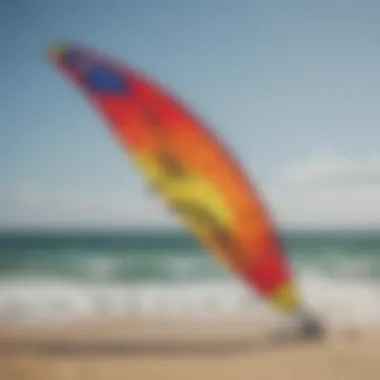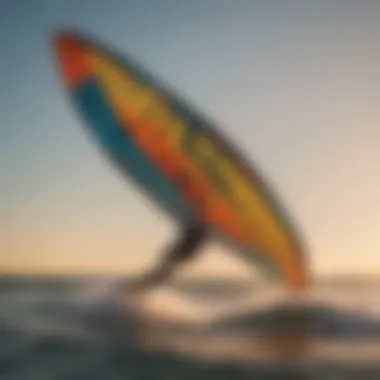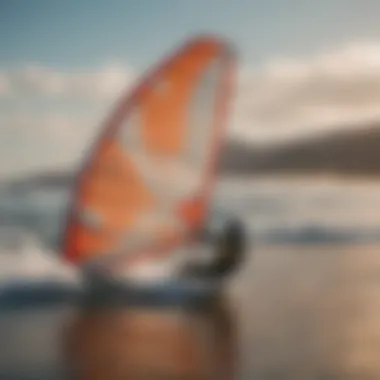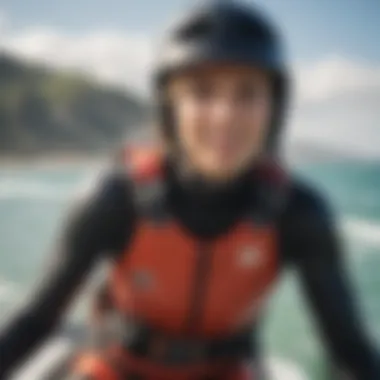Ultimate Guide to Selecting Your Perfect Kiteboarding Kite


Intro
Kiteboarding, merging the thrills of surfing and kite flying, has gained remarkable popularity over the years. Understanding how to buy the right kiteboarding kite can be a daunting task, especially for novices. This guide aims to provide valuable insights and analysis to help both beginners and experienced kiteboarders navigate this complex process. Purchasing a kite can be pivotal to enhancing your overall experience on the water.
In this guide, we will delve into various factors to consider when selecting a kiteboard kite. Not only will we explore the types of kites available, but we will also discuss essential features to evaluate, safety aspects, and maintenance tips. Understanding personal preferences and how they influence kite choice will also be highlighted.
By the end of this article, readers should feel empowered to make informed decisions about their kite purchases, ensuring they choose a kite that aligns with their skill level and aspirations in this exhilarating sport.
Prolusion to Kiteboarding
Kiteboarding, at its core, is a thrilling water sport that combines aspects of both surfing and paragliding. Understanding kiteboarding is critical for anyone considering this activity as a hobby or sport. As kiteboarding gains popularity worldwide, it becomes essential to grasp its fundamentals. This knowledge not only enhances enjoyment but also ensures safety on the water.
A significant part of kiteboarding involves flying a specially designed kite that is controlled by the rider. The kite harnesses wind energy to propel the rider across the water on a board. This section will specifically address the essentials of kiteboarding, making it easier for newcomers to engage with the sport adequately.
Understanding the Basics of Kiteboarding
Before diving into the specifics of kiteboard selection, it's crucial to grasp the fundamentals of the sport itself. Kiteboarding requires not only physical prowess but also mental concentration. Riders must learn about the various components such as kites, boards, control bars, and safety equipment.
The basics also involve understanding wind power. Knowledge of wind directions, strength, and how to read conditions can significantly impact a rider's experience and safety. Additionally, newcomers should familiarize themselves with the proper stance, balance, and techniques needed to ride effectively. Learning these skills often involves taking lessons from a certified instructor to ensure safe and structured learning.
Why Choosing the Right Kite Matters
Selecting the appropriate kite can be the difference between an enjoyable experience and one fraught with difficulty. Each type of kite is designed for specific conditions and rider preferences. A wrong choice can lead to frustration, lack of control, and potential safety hazards.
The kite's size and design need to align with the rider’s skill level, weight, and intended riding style. Kites come in various shapes and sizes, impacting their handling and performance. For example, a larger kite is suitable for lighter winds, while a smaller kite is preferable in stronger winds. Moreover, understanding aspects like the kite’s aspect ratio and material is also essential. With an informed choice, riders can optimize their performance and enjoy the sport to its fullest.
"Choosing the right kit is crucial not only for performance but also for safety on the water."
By emphasizing the importance of these considerations in this introduction, we set the stage for a detailed exploration of the various kites available, essential features, and the best practices to ensure a safe and enjoyable kiteboarding experience. Engaging with kiteboarding can be rewarding; understanding its fundamentals and making informed choices about equipment will pave the way for countless adventures on the water.
Types of Kiteboarding Kites Available for Sale
When it comes to kiteboarding, the type of kite you choose can significantly impact your overall experience and performance. Each kind of kite serves different purposes and conditions, making it essential to understand their characteristics and benefits. Selecting the right kite is vital not only for safety but also for enhancing your kiteboarding skills and enjoyment. This section delves into the primary types of kites available for purchase, ensuring you can make an informed decision.
Foil Kites
Foil kites are designed with a series of internal chambers or cells that create an airfoil shape. This design allows them to fill with air while in use. The primary advantage of foil kites is their efficiency in light wind conditions. They are often lighter and more compact than other types, making them ideal for traveling. However, they can be less stable in turbulent winds compared to inflatable options.
Key Features of Foil Kites:
- Lightweight and portable
- Excellent for low-wind conditions
- Versatile in various water sports
Despite their advantages, users should be cautious, as they may require precise handling and control skills, particularly in gusty conditions.
Leading Edge Inflatable (LEI) Kites
Leading Edge Inflatable (LEI) kites are the most common type used in kiteboarding. They feature an inflatable leading edge that maintains their shape and stability in various wind conditions. LEIs are designed for a wide range of skills, making them suitable for both beginners and experienced riders.
Advantages of LEI Kites:
- Stability and user-friendly
- Performs well in a variety of wind conditions
- Easy to relaunch after crashes in water
These kites are generally more forgiving, providing confidence to new riders while still offering performance advantages for seasoned kiteboarders.
Delta Kites
Delta kites are characterized by their triangular shapes and are a sub-type of LEI kites. They have a unique design that allows them to perform exceptionally well across a variety of winds. Their shape provides increased lift and stability, making them a popular choice among recreational and competitive riders.
Benefits of Delta Kites:


- Enhanced stability in turbulent winds
- Greater low-end power, ideal for lighter winds
- Efficient rather than demanding on the rider
Delta kites are often recommended for those looking for a kite that efficiently handles a range of conditions without complex control inputs.
C-Kites
C-Kites are among the original designs in kiteboarding and maintain a classic C-shape structure. They excel in performance-oriented riding, making them favoured by expert riders and those interested in freestyle and jumping maneuvers. C-Kites offer a direct response to input from the control bar, offering more precision and speed.
Key Characteristics of C-Kites:
- Highly responsive to rider commands
- Great for tricks and maneuvers
- Best suited for high-wind conditions
However, these kites often require a higher skill level to use effectively, making them less ideal for beginners. It is crucial to consider your riding style and experience level when evaluating whether a C-Kite is suitable for you.
Conclusion of Kite Types:
When purchasing a kite, understanding these different options will aid significantly in your decision. Each type of kite provides unique benefits and comes with distinct handling requirements. By aligning your choice with your skill level and riding conditions, you can enhance your kiteboarding experience.
Essential Kite Features to Consider
When purchasing a kiteboarding kite, understanding the essential features is crucial for an informed decision. Each feature plays a role in performance and safety, and ignoring them can lead to unsatisfactory experience. This section covers key elements like size, material, bridle system, and control characteristics, offering insights into their importance.
Size and Aspect Ratio
The size of the kite significantly impacts how it performs in different wind conditions. A larger kite captures more wind, providing more lift, which is advantageous for beginners and heavy riders. However, it can become difficult to control in strong winds.
The aspect ratio is also an important consideration. It measures the wingspan to the center width. Kites with a higher aspect ratio glide more efficiently and are faster but require more skill to maneuver. Conversely, low aspect ratio kites offer greater stability and responsiveness, making them suitable for novices. Understanding your skill level and the typical wind conditions will assist in selecting the right size and aspect ratio.
Material and Durability
The material used in kite construction affects both durability and performance. Most modern kites are made from ripstop nylon or polyester. Ripstop nylon is preferred for its lightweight and resistance to tearing. However, it might not have the same longevity as heavier materials.
UV resistance is another factor. UV exposure can weaken fabrics over time. A kite made with UV-resistant materials will last longer, thus offering better value for your investment. Be sure to inspect the stitching and seams as well, as quality craftsmanship adds to the overall durability, protecting against wear and tear during use.
Bridle System
The bridle system is a network of lines that connects the kite to the main flying line. It affects how the kite flies and how easily it can be controlled. A well-designed bridle allows for a stable flying experience, which is essential for new riders.
Pay attention to whether the bridle is adjustable. Adjustability can help in tuning the kite’s performance according to specific wind conditions or rider preferences. A more complicated bridle can offer improved performance, yet it may also require a deeper understanding for optimal usage.
Control Bar Characteristics
The control bar serves as the primary interface between the rider and the kite. Understanding its features is key to effective kite handling. Look for a control bar that offers comfortable grips and ergonomic design. This helps during long sessions on the water.
The length of the bar is another consideration. Bars come in different sizes, and the appropriate length depends on the size of the kite and the rider’s preferences. A shorter bar can provide better control at high speeds, while a longer bar is typically easier to handle for beginners.
In addition, the safety features of a control bar, such as quick releases and safety leashes, should also be evaluated. These elements can prevent accidents and ensure the rider's safety in emergency situations.
Remember: Choosing the right features in a kiteboard kite can greatly enhance your overall experience in the sport.
Where to Find Kiteboarding Kites for Sale
Finding the right kiteboarding kite can be a challenge, especially with the variety of options available. This section highlights where one can acquire kiteboarding kites effectively, ensuring a balance between quality, price, and suitability. The places discussed in this section not only differ in their offerings but also in the shopping experience they provide. Understanding where to buy can lead to better decisions and satisfaction with your kite, whether you are a beginner or have more experience.
Retail Stores Specializing in Kiteboarding Gear
Visiting specialized retail stores is an ideal choice for those who prefer to see and touch the products before making a purchase. Such stores provide a range of benefits. First, customers can receive personalized advice from knowledgeable staff who understand the nuances of kiteboarding equipment.
Second, trying out kites in a controlled environment helps in assessing their size and feel. Many local retailers, like "Real Watersports" and "The Kite Store", often stock the latest models from reputable manufacturers. These shops may also offer demo days where customers can test kites on the water before making a decision.
However, it is essential to check the store's reputation and customer feedback. A well-reviewed store often ensures quality service and products. Additionally, local stores sometimes have partnerships with kiteboarding schools. This connection can provide access to exclusive offers and promotions.


Online Marketplaces and Websites
The rise of e-commerce has revolutionized how kiteboarding enthusiasts buy their gear. Websites such as "Amazon", "eBay", and "Kiteboarding.com" offer an extensive range of kites from various brands and types. The convenience of online shopping cannot be overstated; customers can browse from the comfort of their homes and easily compare prices across several sellers.
Benefits of shopping online include:
- A broader selection of kites
- User reviews and ratings
- Often better pricing due to competition among sellers
- The ability to filter search results based on specific needs
While online shopping is convenient, pay attention to various factors like shipping costs and return policies. Ensure the seller offers a good return policy, as this provides assurance in case the kite does not meet your expectations. It is also beneficial to research the brand to grasp its reputation for quality.
Local Kiteboarding Communities and Clubs
Engaging with local kiteboarding communities can be a valuable resource when searching for kites. Many passionate kiteboarders often buy and sell equipment within their community. This offers an opportunity to find second-hand kites, which can be a cost-effective option for beginners or those trying out a new style of kiteboarding.
Joining a local club often comes with several advantages:
- Networking opportunities with experienced kiteboarders
- Educational workshops on gear maintenance and usage
- Exclusive access to community events and discounted gear
Social platforms like "Facebook" groups and forums on "Reddit" can also be valuable for connecting with other enthusiasts. Here, discussions often involve recommendations for where to buy kites and information on sales or trades within the community.
Ultimately, where you choose to buy a kiteboarding kite can significantly affect your experience. Balancing personal preference with thorough research ensures that you find the kite that fits your needs best.
Overall, understanding these options allows for strategic decision-making and can lead to a more satisfactory kiteboarding experience.
Evaluating Prices and Deals
Understanding prices and deals is crucial when purchasing a kiteboarding kite. Kiteboarding gear can represent a significant investment, making it essential to assess costs carefully to avoid overspending or compromising on quality. Evaluating prices helps you determine the market value of a kite, ensuring you make a well-informed purchase. This process also allows you to consider factors such as brand reputation, durability, and performance capabilities, which are key in finding the right kite for your needs.
It is important to evaluate not only the price but also the deals available. Special promotions, discounts, and package offers can provide significant savings. However, one should always scrutinize what these deals entail to avoid unknowingly sacrificing quality for a lower price.
How to Compare Prices Effectively
When comparing prices for kiteboarding kites, first gather a broad spectrum of options. Start by checking multiple shops and online retailers. Comparing prices across different platforms provides insight into the general pricing landscape, allowing you to spot anomalies and opportunities for savings. You might consider listing prices based on various criteria:
- Brand: Different brands have distinct pricing strategies.
- Material Quality: Higher-priced kites may use superior materials.
- Model Year: Newer models often carry a premium price.
- Retailer Reputation: Well-established retailers may offer warranties or customer support.
Make note of the features that each kite offers. A lower price might indicate fewer features or less durable materials. Structured lists can help visualize these comparisons, making your decision-making process clearer.
Identifying Quality Deals
Identifying quality deals requires a discerning eye. When browsing for kites, keep an eye out for certain indicators that point to a good bargain:
- Warranty: A solid warranty often correlates with quality.
- Reviews: Customer feedback can reveal the true value of the kite beyond its price.
- Bulk Purchases: Sometimes, buying a kite with supplementary equipment can lead to savings.
- Sale Seasons: Retailers often discount products during specific times, such as off-peak seasons or during holiday sales.
"Always prioritize the kite's performance characteristics and durability over price. A high-quality kite will serve you better in the long run, even if it’s initially more expensive."
In summary, take your time to evaluate prices and analyze the deals available. Paying close attention to these aspects can lead to a more satisfying purchase that aligns with both your budget and kiteboarding aspirations.
Safety Considerations in Kiteboarding
Kiteboarding can be a thrilling sport, but it also comes with its own set of risks. For both beginners and experienced riders, understanding safety considerations is essential. This section highlights key elements that can enhance your safety on the water and minimize the potential for accidents.
Understanding Kite Size and Wind Conditions
One significant safety aspect in kiteboarding is understanding the relationship between kite size and wind conditions. Each kite is designed to perform optimally within a specific wind range. Larger kites are suitable for light winds but can become unmanageable in stronger conditions. Conversely, smaller kites can handle high winds but require more strength and skill to control.
Considerations include:
- Know the wind speed: Before heading out, check the local wind forecast. Being aware of wind speed helps in selecting an appropriate kite size.
- Evaluate the environment: Wind conditions can vary due to terrain or obstacles. It's wise to familiarize yourself with the spot before kiteboarding.
- Personal skill level: Assess your own experience and skills. If uncertain about controlling a larger kite, opt for a smaller one. Always prioritize safety over thrill.


"Understanding wind conditions not only increases your safety but also enhances your overall kiteboarding experience."
Safety Gear Essentials
Equipping yourself with the right safety gear is non-negotiable for any kiteboarder. It can drastically reduce injuries during unforeseen incidents. Here are vital components to consider:
- Harness: A comfortable harness distributes the pull of the kite across your body, enabling better control.
- Helmet: Protects your head from potential accidents. Look for helmets specifically designed for water sports.
- Impact Vest: This vest provides additional buoyancy and protection against impacts.
- Leash: A quality leash connects you to the kite. It is crucial in preventing the kite from drifting away if you fall.
- Safety Knife: Having a safety knife handy allows for quick action if you need to cut a tangled line.
Without these gear elements, even a small accident can result in serious injuries. Make a habit of checking your gear before each session to ensure everything is in top condition.
By understanding kite size, analyzing wind conditions, and utilizing appropriate safety gear, you set the stage for not just a safe ride, but a more enjoyable experience overall.
Maintenance and Care for Kiteboarding Kites
Taking care of your kiteboarding gear is crucial for ensuring its longevity and performance. Proper maintenance reduces the risk of accidents and enhances the overall kiteboarding experience. Investments in quality gear require time and effort to maintain. Additionally, neglect can lead to costly repairs or replacements.
Proper Storage Techniques
Storing your kite correctly when not in use is a key part of maintenance. Here are some important points to consider:
- Location: Choose a cool, dry place away from direct sunlight. Excessive heat can weaken materials over time. A garage or a room with stable temperatures works well.
- Cleaning: Before storing, rinse your kite with fresh water to remove salt, sand, or dirt. Allow it to dry fully to prevent mold or mildew.
- Packing: When packing your kite, avoid over-folding or crushing it, as this can damage the canopy. Use a storage bag designed for your kite.
Adhering to these storage techniques can prolong the life of your kites and maintain their performance.
Repairing Common Issues
Kites can experience various issues, whether from wear and tear or unexpected incidents. Knowing how to address these problems is essential for any kiteboarder. Common issues include:
- Tears and Rips: Small tears can be repaired easily using adhesive tape made for sails or kites. If the damage is more extensive, a patch or a professional repair may be necessary.
- Bridle Damage: Regularly inspect your bridle lines for fraying or knots. Replace damaged lines to ensure optimal control and stability during rides.
- Inflation Problems: Ensure that the inflation valves are clean and functioning. Leaks can happen, so inspect them regularly. If there are holes, use repair kits that specifically target inflatable materials.
Repairs not only extend the lifespan of kites but also ensure safety on the water. Additionally, it’s wise to have a basic repair kit on hand when heading to the beach.
"Regular maintenance and timely repairs can make a significant difference in the performance and safety of your kiteboarding kites."
By following these maintenance guidelines, you ensure your kiteboarding kites remain in top condition, ready for endless adventures on the water.
Personal Preferences in Kite Selection
Personal preferences are a fundamental aspect when choosing a kiteboarding kite. Each rider has unique needs and experiences that directly influence their choice. It is essential to understand that what works for one may not necessarily work for another. The role of personal preferences extends beyond basic enjoyment; they can impact the overall safety, performance, and satisfaction during kiteboarding sessions.
Rider Skill Level and Experience
The rider's skill level and experience play a significant part in the selection process. Beginners may seek kites that offer stability and easy handling. A smaller aspect ratio is usually desired for increased control. This is often paired with a leading-edge inflatable kite, which provides a forgiving experience in various wind conditions.
Conversely, more advanced kiteboarders typically favor kites that offer higher speed and better performance in challenging conditions. These individuals may gravitate toward C-kites or delta kites, which allow for increased maneuverability and responsiveness.
When selecting a kite, the experience level should shape the decision. New riders must feel confident and secure on the water, while seasoned riders often want an exhilarating experience. Having the right kite boosts confidence and leads to a more enjoyable time on the water.
Preferred Riding Style
Another critical element of personal preference is the rider's preferred style. Kiteboarding includes various styles such as freestyle, wave riding, and racing. Each style demands specific kite characteristics. For instance, freestyle riders tend to choose kites with a good hang time and quick re-launch capability. This allows for tricks and landings that require precision.
On the other hand, wave riders often look for kites that perform well in dynamic wind conditions and can respond quickly. This type of rider might prefer a kite that is easy to depower and has smooth power delivery. Racing enthusiasts desire kites that provide maximum speed, stability, and efficient turning capabilities.
In summary, evaluating personal preferences in kite selection is crucial. Understanding one's skill level and preferred riding style can significantly affect the overall experience. This targeted approach allows riders to choose kites that resonate with their individual requirements, ultimately leading to enhanced satisfaction on the water.
Ending
The conclusion serves as a critical element in understanding the overall journey of selecting the right kite for kiteboarding. A clear and coherent conclusion consolidates the insights provided throughout the article. It emphasizes the importance of making informed choices and highlights the key elements discussed. Choosing the appropriate kite is not merely about preference; it heavily impacts performance, safety, and enjoyment.
It is essential to consider various factors, including the type of kite, features, price, and personal preferences. By integrating these details into your decision-making process, you maximize your potential for a rewarding kiteboarding experience.
Final thoughts on the subject also stress the value of practical knowledge gained from various sources such as retail experiences, online interactions, and community advice. Being well-informed enables riders, regardless of skill levels, to navigate the market with confidence and select a kite that aligns with their unique riding style and conditions.
Select the right kite helps not only in boosting performance but also enhances safety on water.
Ultimately, the selection process is more than a mere transaction; it represents a commitment to the sport and personal growth as a rider. Understanding your needs and aligning them with your equipment can greatly enrich the kiteboarding experience.







